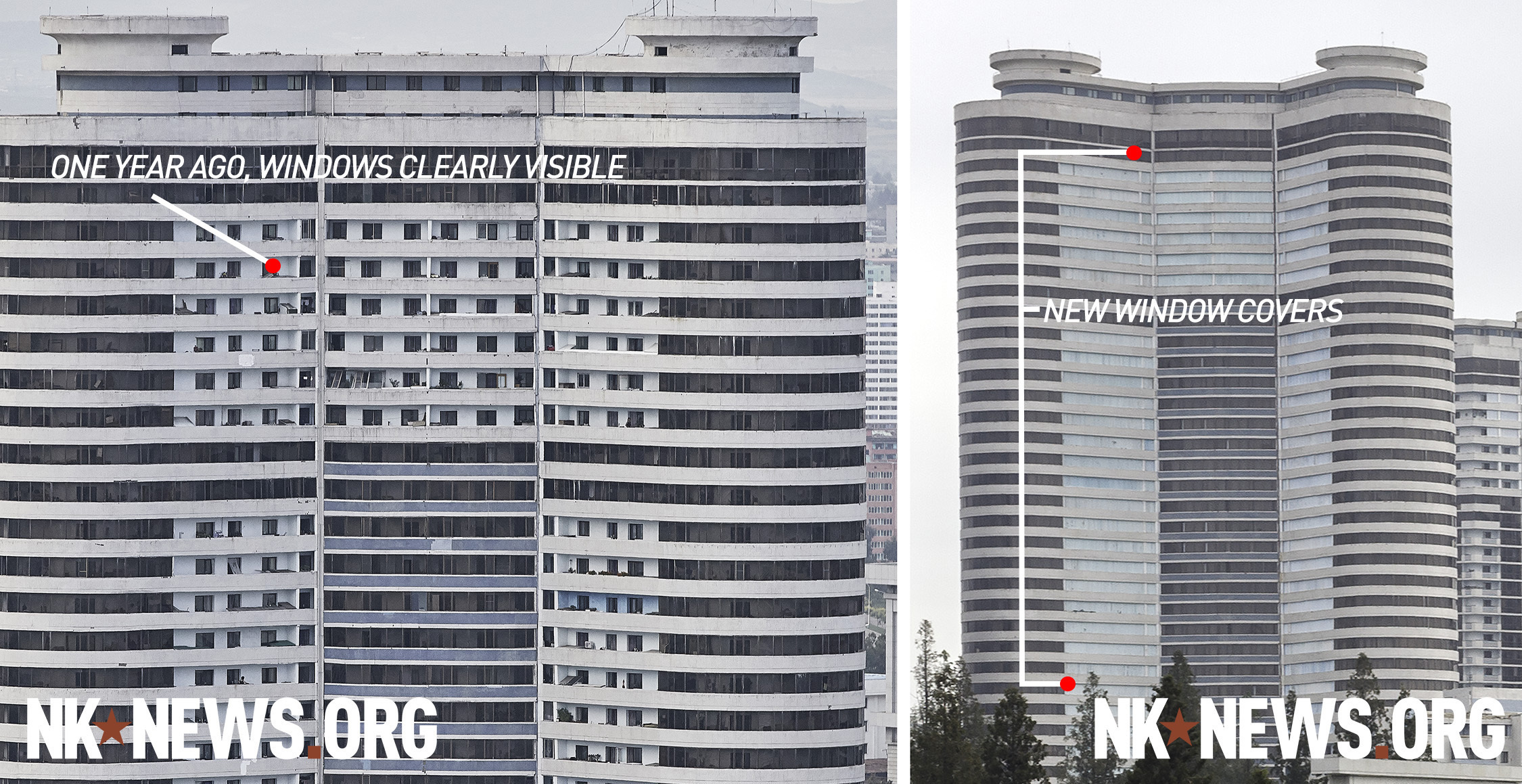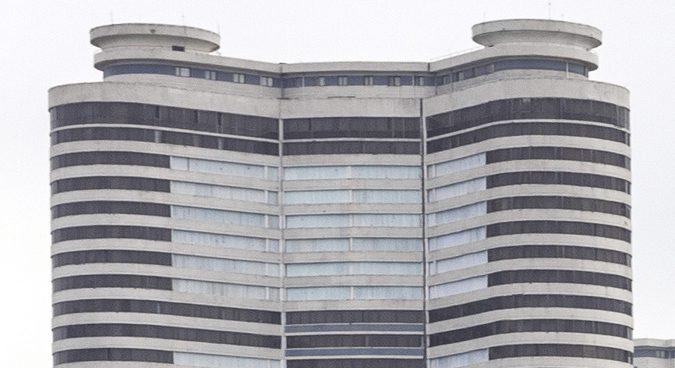Windows in the upper sections of buildings facing towards or near the ‘forbidden city’ complex in central Pyongyang have been blocked with opaque covers or one-directional slats, photographs of multiple buildings in its vicinity indicate.
The ‘forbidden city’ is a cordoned-off section of Pyongyang – which has undergone major construction lately – containing key facilities like the Workers Party of Korea (WPK) headquarters and luxury apartments for senior officials.
Buildings near the Koryo Hotel and Kim Il Sung Square, as well prestige developments like the Changchun Street apartment complex – built for Kim Il Sung’s 100 year anniversary – have all been impacted by the changes, NK News understands.
Left: September 2018 view of one of the Changchun complex tower blocks | Right: September 2019 view of the Changchun complex tower block facing towards the ‘forbidden city’ of Pyongyang | Click to enlarge | Pictures: NK News
But it’s not just local citizens who are experiencing the impact of the unusual obstructions.
Tourists staying at the Koryo Hotel in the past month, located near one of the roadblock entrances of the forbidden city area, said that windows in upper floor sections there had been recently replaced with translucent covers, obscuring views of the Pyongyang skyline.
“It just shows DPRK in the worst way,” said one regular visitor to the hotel. “Every tourist that sees that automatically thinks: ‘they even block windows so I don’t see anything outside’”.
View from atop the Koryo Hotel in recent weeks | Click to enlarge | Pictures: NK News
Furthermore, as of last week authorities in the capital took the unprecedented step of prohibiting photographs from the city’s iconic Juche Tower without explanation. The panoramic view from the top notably offers a clear perspective over parts of the forbidden city area most recently under construction.
In addition, September also saw authorities stop tourists from taking helicopter tours over the city, NK News understands from informed sources. The helicopter route normally used on the tours also affords clear views of the forbidden city area, though doesn’t fly over it directly.
Notably, the photos obtained by NK News come after the Seoul-based outlet Daily NK said that its sources in Pyongyang had noticed similar coverings on windows throughout the city.
“The authorities have blocked off the windows of apartments higher than important institutions like the KWP Headquarters,” a source told the Daily NK. “People who looked like MSS came to make and install concrete shutters.”
The Daily NK said the measure was taken to prevent people from taking photos of major institutions and sending them out of the country, and was also intended to stop people from being able to look down on Party Headquarters.
An assortment of buildings situated nearby Kim Il Sung Square all show covers and slats reportedly to prevent residents seeing nearby government areas | Click to enlarge | Pictures: NK News
UP CLOSE AND PERSONAL
Close-up photos of buildings in the vicinity of the ‘forbidden city’ seen by NK News reveal an array of measures to stop residents being able to see out of windows.
Some windows feature all-encompassing covers, while others include slats which appear designed to significantly reduce the view outside, while also preventing people seeing in specific directions.
Notably, a close analysis of impacted buildings shows that the window obstructions only begin at certain floors, with lower floor windows appearing clear as before.
Calvin Chua, an architect who regularly visits the DPRK with the Choson Exchange NGO, said that the coverings comprised some unusual characteristics.
“At first glance, those panels seem like sunshading devices,” he said. “But since they do not look movable and are only located on the high floors, it seems to be shading views rather shading the sun.”
CAUSE FOR CONCERN?
Besides obstructing once pristine views of the city, the measures are likely to make the interiors of impacted buildings extremely dark in a city well known for power outages and electrical shortages.
As a result, the covers are likely to worsen the quality of life for those residents most effected.
“This is emblematic of how the North Korean state’s hyper-security orientation and obsessive paranoia upends rational policymaking that could improve the everyday living conditions of North Korean people in big and small ways,” said Sokeel Park, research director of the Liberty in North Korea (LiNK) NGO.
“Also, when you barge in and take something away from people rather than denying it from the start, that tends to piss people off even more,” he continued.
Observers had mixed interpretations about what may have caused the changes.
Peter Ward, a regular analyst with NK Pro, said the development could be related to an attempt to prevent information leakage.
“Why the roofs of major state and party institutions are considered classified, I am not exactly sure, but perhaps they don’t want people gathering intel on who can be seen in the windows of these buildings,” he said.
“Either way, it fits into a culture of secrecy that seems to have combined with supercharged UN sanctions post-2016, resulting in a campaign to make a lot of even innocent things into secrets that foreigners or even many North Koreans aren’t allowed to see.”
Christopher Green of the International Crisis Group meanwhile said the location of the window coverings – in tower blocks adjacent to sensitive party buildings – could explain why authorities have taken such a drastic measure.
“We don’t know what credible evidence of assassination attempts the North Korean Ministry of State Security might have received, or even actual assassination attempts such as the ‘juniper tree’ incident of Kim’s early rule,” he said.
“Assassination attempts from high windows cannot be ruled out.”
The Juniper tree incident was an assassination attempt on Kim Jong Un’s life reported by the Joongang Ilbo as having taken place in 2014.
“Equally, Kim is an autocratic dictator, and we cannot know how deeply his paranoia may run.”
Source:www.nknews.org
 Left: September 2018 view of one of the Changchun complex tower blocks | Right: September 2019 view of the Changchun complex tower block facing towards the ‘forbidden city’ of Pyongyang | Click to enlarge | Pictures: NK News
Left: September 2018 view of one of the Changchun complex tower blocks | Right: September 2019 view of the Changchun complex tower block facing towards the ‘forbidden city’ of Pyongyang | Click to enlarge | Pictures: NK News An assortment of buildings situated nearby Kim Il Sung Square all show covers and slats reportedly to prevent residents seeing nearby government areas | Click to enlarge | Pictures: NK News
An assortment of buildings situated nearby Kim Il Sung Square all show covers and slats reportedly to prevent residents seeing nearby government areas | Click to enlarge | Pictures: NK News


